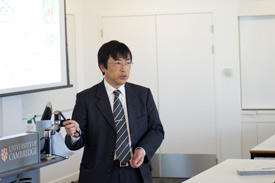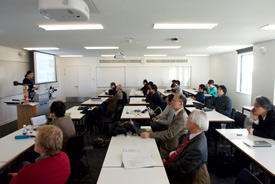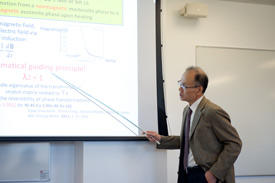

01/26/2015

In early December, the Advanced Institute for Materials Research (AIMR) and the University of Cambridge held a joint workshop in the UK to share their latest discoveries, encourage student exchange and reinforce longstanding partnerships. The event saw presentations on the catalyzing properties of sponge-like nanoporous gold, explorations into the atomic landscape of perovskites and a mathematician’s take on materials science.
On the morning of December 9, Susumu Satomi, president of Tohoku University, and Jeremy Sanders, pro-vice-chancellor for institutional affairs at the University of Cambridge, signed a declaration of intent to deepen academic and research collaboration between the two universities. The signing ceremony was attended by AIMR Director Motoko Kotani together with a representative from the Embassy of Japan in the UK and several professors with expertise in the areas of global safety and materials science. More than 40 individuals were present for the program.
The two universities established an AIMR Joint Center (AJC) back in 2012. “In the few years that the center has been operational, it has really developed into a focal point for promoting and strengthening AIMR’s presence in Cambridge,” says Katherine Orchard, a researcher at the AJC who spends most of her time in Erwin Reisner’s laboratory at the Department of Chemistry in Cambridge. Orchard is focusing on the development of nanostructured materials that can absorb solar energy and their use to split water into its constituent elements, hydrogen and oxygen, ultimately paving the way for hydrogen-powered vehicles and electrical devices. “Both the University of Cambridge and the AIMR are recognized as world-class institutions and knowledge transfer between the two can only lead to better research,” she adds.

On the day after the official signing ceremony, Orchard joined more than 50 students and researchers at the workshop on December 10 to listen to plenary lectures and discuss the latest trends and controversies in areas such as metallurgy, spintronics and topological insulators.
A parallel session was held to discuss opportunities for student and research exchange between the AIMR and the University of Cambridge. Representing the AIMR, Administrative Director Masaru Tsukada delivered a presentation on the Global Intellectual Incubation and Integration Laboratory (GI3 Lab), a unique research exchange program in which excellent young researchers are brought to Sendai and hosted at the AIMR for one to three months.
Among the presenters at the scientific sessions was Naoki Asao, a professor at the AIMR who has previously collaborated with Reisner’s laboratory in the development of water-splitting systems. Asao shared his work on the use of nanoporous gold for novel, selective chemical transformations, resulting in the production of a variety of valuable organic molecules in a more environmentally sustainable way than existing methods.
Almost a quarter of a century ago, scientists discovered that the synthesis of nanosized particles of gold transformed the catalytically inert metal into a remarkable agent for change. However, these nanoparticles tend to huddle back together into larger particles, losing their catalytic powers. Now, Asao and his colleagues have discovered that nanoporous gold materials, riddled with tiny holes between 10 and 50 nanometers in diameter, have durable structures and high catalytic activity and can be recovered for reuse, thus making them ideal catalysts for synthetic chemistry.
In another presentation, Taro Hitosugi, an associate professor in the AIMR Materials Physics Group, elaborated on the use of scanning tunneling microscopy to closely observe oxide thin films with perovskite structures and potentially engineer their growth, atom by atom. These materials exhibit the fascinating properties of high-temperature superconductivity and magnetoresistance.

Mathematician and professor at the AIMR Yasumasa Nishiura reminded the audience of the historical rapport between representatives in the fields of mathematics and materials science. He went on to elaborate on the potential for mathematics to describe amorphous materials that lack a repetitive atomic structure, such as glass, for which no reliable model exists.
To further foster the close relationship between these two fields of intellectual endeavor, Nishiura’s Mathematics Unit has set up a research group with the experimental laboratories of Lindsay Greer at the University of Cambridge and Tadafumi Adschiri at the AIMR and is beginning to extend these links to mathematics departments at Cambridge. “Today’s scientific activities are becoming more and more borderless,” says Nishiura, “and consequently joint research centers are important to support the exchange of information and people, especially for theoretical sciences like mathematics.”
“The success of the workshop at Cambridge proved that the AIMR Joint Research Center is an important asset for advancing research in the field,” says a pleased Kotani. “I am happy that these efforts helped to strengthen the relationship between Tohoku University and the University of Cambridge and anticipate further acceleration in research and more international recognition.”